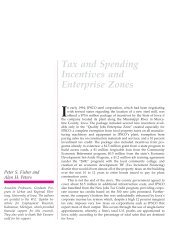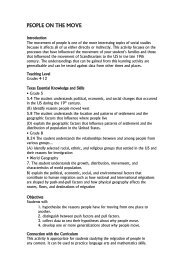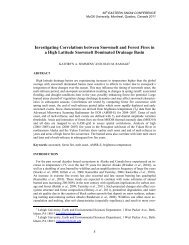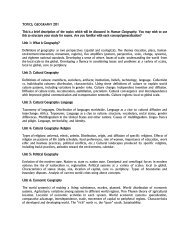Texas Social Studies Framework - Department of Geography ...
Texas Social Studies Framework - Department of Geography ...
Texas Social Studies Framework - Department of Geography ...
Create successful ePaper yourself
Turn your PDF publications into a flip-book with our unique Google optimized e-Paper software.
32<br />
32<br />
plans. (Consult Appendix B: Resources for Enhancing<br />
<strong>Social</strong> <strong>Studies</strong> Curriculum, Instruction, and Assessment.)<br />
Instructional Unit Plans<br />
Instructional unit plans provide very specific<br />
guidelines regarding how the instructional program<br />
is organized and delivered. They contain detailed<br />
performance objectives, the organization and<br />
sequence <strong>of</strong> units and/or topics, suggestions for<br />
instructional strategies and activities, specific<br />
suggestions for assessment, and lists and descriptions<br />
<strong>of</strong> resources available to support instruction,<br />
e.g., books, videos, CD-ROMs, websites, etc. These<br />
curriculum documents are especially useful to<br />
classroom educators (Armstrong, pp. 103-104).<br />
The SSCED website includes annotated bibliographies <strong>of</strong><br />
books and CD-ROMs as well as links to other websites<br />
that contain useful information for developing instructional<br />
unit plans.<br />
Instructional unit documents are intended primarily for<br />
the use <strong>of</strong> classroom educators. They are the most<br />
specific <strong>of</strong> the set <strong>of</strong> interrelated documents described in<br />
this section, providing detailed and practical information<br />
for the delivery <strong>of</strong> the curriculum in the classroom. Good<br />
instructional units are <strong>of</strong> invaluable assistance to all busy<br />
classroom educators, but are especially helpful at the<br />
elementary level, where a single teacher might have to<br />
plan for and carry out instruction that incorporates as<br />
many as seven or eight different sets <strong>of</strong> TEKS. These<br />
documents ease the classroom educator’s burden <strong>of</strong><br />
having to plan curriculum on a daily or weekly basis and<br />
allow them to devote more time to the critical elements<br />
<strong>of</strong> instruction and assessment. Instructional unit documents<br />
fulfill an important legal function for districts in<br />
that they are built upon the documents described in early<br />
parts <strong>of</strong> this section and, therefore, incorporate the TEKS<br />
as mandated by state laws and regulations.<br />
Useful instructional unit documents incorporate performance<br />
objectives based on the TEKS for <strong>Social</strong> <strong>Studies</strong><br />
(as well as other TEKS when appropriate), identification<br />
<strong>of</strong> important ideas (concepts and generalizations),<br />
specific suggestions for delivery <strong>of</strong> instruction (lesson<br />
plans and activities), specific suggestions for assessment<br />
(performance tasks and rubrics), and identification <strong>of</strong><br />
useful instructional resources (fiction and nonfiction<br />
books, CD-ROMs, websites, videos, etc.). They might<br />
also include suggested modifications for special populations,<br />
enrichment and extension activities, suggestions<br />
for formative evaluation and reteaching, and ideas for<br />
Chapter 4: Developing <strong>Social</strong> <strong>Studies</strong> Curriculum Based on the TEKS<br />
linking social studies with other subject areas, e.g., world<br />
history and literature or U.S. history and technology. To<br />
insure the implementation <strong>of</strong> the TEKS for <strong>Social</strong><br />
<strong>Studies</strong>, careful consideration needs to be given to the<br />
development <strong>of</strong> good instructional unit documents.<br />
SHOULD DISTRICTS WAIT UNTIL NEW<br />
SOCIAL STUDIES TEXTBOOKS ARE<br />
ADOPTED BEFORE DEVELOPING THE SOCIAL<br />
STUDIES CURRICULUM?<br />
No. New social studies textbooks will not be adopted by<br />
the State Board <strong>of</strong> Education until 2002. Classroom<br />
educators need assistance in implementing the TEKS for<br />
<strong>Social</strong> <strong>Studies</strong> now. Waiting on the adoption <strong>of</strong> new<br />
textbooks before developing curriculum is a sure<br />
prescription for a low level <strong>of</strong> implementation <strong>of</strong> the<br />
TEKS for <strong>Social</strong> <strong>Studies</strong>.<br />
Most education pr<strong>of</strong>essionals recognize that social<br />
studies textbooks and their related support materials are<br />
useful resources for both teachers and students; however,<br />
there is nearly unanimous agreement that the curriculum<br />
should consist <strong>of</strong> more than the contents <strong>of</strong> a textbook.<br />
They also agree that curriculum development should<br />
precede, not follow, the adoption <strong>of</strong> textbooks. Textbooks<br />
should be chosen to fit and support the curriculum, rather<br />
than determine the curriculum.<br />
District level educators generally have an intimate<br />
knowledge <strong>of</strong> the needs and interests <strong>of</strong> their students,<br />
the skills and abilities <strong>of</strong> their pr<strong>of</strong>essional staff, community<br />
and district level resources available to support the<br />
local curriculum, the requirements <strong>of</strong> state mandates, and<br />
the organization and operation <strong>of</strong> their schools. Large<br />
national and international publishing conglomerates lack<br />
this intimate knowledge and, therefore, <strong>of</strong>ten cannot<br />
make the critical decisions that insure optimal learning<br />
for students.<br />
Textbooks serve as useful curriculum resources but they<br />
cannot be relied on as a curriculum. Think about how<br />
multiple sources can be used to help teach the TEKSbased<br />
curriculum adopted in a local district. Here are<br />
some reasons why multiple sources are needed to<br />
augment the selected textbook:<br />
• Most textbooks are written for a national<br />
audience and cannot include multiple examples<br />
<strong>of</strong> content drawn from regional or local areas<br />
that can contextualize student learning and
















